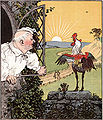Handmade paper
Handmade paper or short- laid paper is a with a sieve from the tub , a tub-shaped vessel scooped paper . In terms of craftsmanship, it represents the historically original production of paper.
Texture and manufacture
Handmade paper is scooped from a thinned fiber pulp of rag or cellulose , the so-called whole material (whole material), with the help of a ladle sieve. As a rule, the pulp consists of a large proportion of rags and is mostly wood-free. The handling of the ladle sieves and the fiber content in the vat often results in minimal differences in the paper thickness. The pattern of the ladle screen (the ribbing ) can be recognized by means of translucent light. If shaped pieces of wire are worked into the ladle screen, intended watermarks are created . If the papers remain untrimmed, they have an unevenly shaped and thick edge, the deckle edge.
Since the invention of the cylinder mold machine , handmade paper has mostly been produced industrially (industrial chests). In the artistic and museum sectors, however, it is still made manually in small numbers and scooped by hand. Different materials can be mixed into the paper pulp, for example flower petals. Today, handmade paper is mostly used for high-quality applications in small quantities (e.g. complex letterheads ), for artistic prints or in paper or book restoration .
In the case of imitation handmade paper ( DIN 6730), in contrast to real handmade paper, ribs, watermarks and / or the uneven edge are formed and thus imitated by work steps carried out after the paper production, such as embossing or punching . Imitation watermarks are not waterproof; Since the paper fibers were only compressed during their machine production, they swell up again under the action of water vapor.
Printed handmade paper with visible ribbing, Carl von Linné : Systema naturae (1758)
Flat printed handmade paper with visible ribs, Randolph Caldecott (1887)
Handmade letter paper from Königstein GDR production around 1970
- Manufacture of handmade paper in a factory in Myanmar
See also
literature
- Severin Corsten (Ed.): Lexicon of the entire book system. Volume II, Anton Hiersemann Verlag , Stuttgart 1989, ISBN 3-7772-8911-6 , p. 19.
Web links
- Example of a manufacturer of handmade paper
- Zerkall, example of a manufacturer of machine-made handmade paper
- Handmade paper - a guide to the world of handmade paper on the Internet
- Instructions for scooping and dyeing copperplate paper and for incorporating watermarks
Individual evidence
- ^ Max Zieger: Paper Science. An introduction for paper converters . Leipzig 1952, p. 44.








